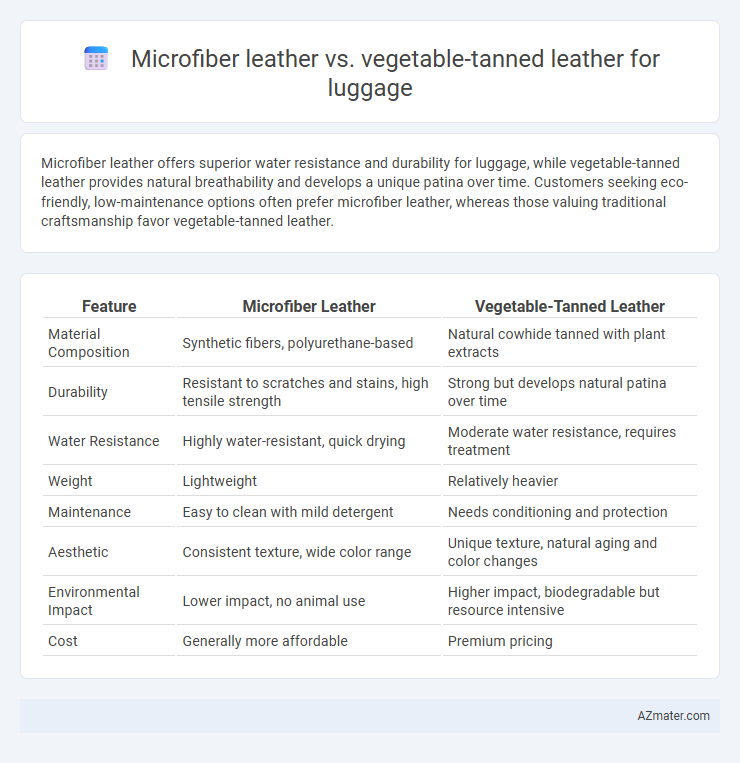Microfiber leather offers superior water resistance and durability for luggage, while vegetable-tanned leather provides natural breathability and develops a unique patina over time. Customers seeking eco-friendly, low-maintenance options often prefer microfiber leather, whereas those valuing traditional craftsmanship favor vegetable-tanned leather.
Table of Comparison
| Feature | Microfiber Leather | Vegetable-Tanned Leather |
|---|---|---|
| Material Composition | Synthetic fibers, polyurethane-based | Natural cowhide tanned with plant extracts |
| Durability | Resistant to scratches and stains, high tensile strength | Strong but develops natural patina over time |
| Water Resistance | Highly water-resistant, quick drying | Moderate water resistance, requires treatment |
| Weight | Lightweight | Relatively heavier |
| Maintenance | Easy to clean with mild detergent | Needs conditioning and protection |
| Aesthetic | Consistent texture, wide color range | Unique texture, natural aging and color changes |
| Environmental Impact | Lower impact, no animal use | Higher impact, biodegradable but resource intensive |
| Cost | Generally more affordable | Premium pricing |
Introduction: Choosing the Right Leather for Luggage
Microfiber leather offers superior water resistance, lightweight durability, and easy maintenance, making it ideal for frequent travelers seeking practicality in luggage. Vegetable-tanned leather provides natural breathability, develops a unique patina over time, and boasts environmentally friendly processing, appealing to those valuing craftsmanship and sustainability. Selecting between microfiber leather and vegetable-tanned leather depends on balancing performance needs with aesthetic preferences for optimal luggage longevity.
What is Microfiber Leather?
Microfiber leather is a synthetic material composed of ultra-fine fibers that mimic the texture and durability of genuine leather, commonly used in luggage for its water resistance and lightweight properties. Unlike vegetable-tanned leather, which is derived from natural tannins in plant materials and offers a distinct aging process and eco-friendly appeal, microfiber leather provides consistent quality and easier maintenance. Its synthetic composition also makes it more affordable and suitable for travelers seeking durable, weather-resistant luggage options.
What is Vegetable-Tanned Leather?
Vegetable-tanned leather is crafted using natural tannins from tree bark, leaves, and other plant materials, resulting in a durable and eco-friendly material ideal for luggage. This traditional tanning process enhances the leather's strength and develops a unique patina over time, improving the aesthetic and longevity of bags and suitcases. Compared to microfiber leather, vegetable-tanned leather offers superior breathability and develops character with age, making it a preferred choice for high-quality, long-lasting luggage.
Durability Comparison: Microfiber vs Vegetable-Tanned Leather
Microfiber leather demonstrates superior resistance to scratches, water, and stains, making it highly durable for luggage exposed to various travel conditions. Vegetable-tanned leather, while developing a unique patina over time, tends to be more susceptible to moisture damage and requires regular maintenance to preserve its strength. The choice depends on the balance between low maintenance and long-term weather resistance versus a natural material that matures aesthetically but demands careful care.
Weight Differences for Travel Convenience
Microfiber leather is significantly lighter than vegetable-tanned leather, enhancing travel convenience by reducing overall luggage weight and making handling easier during transit. Vegetable-tanned leather, while durable and offering superior aging characteristics, tends to be heavier and adds substantial weight to bags, which can be a drawback for frequent travelers prioritizing lightweight gear. Choosing microfiber leather luggage can lead to more comfortable, convenient travel without compromising on style or durability.
Water Resistance and Maintenance Requirements
Microfiber leather offers superior water resistance compared to vegetable-tanned leather, making it ideal for luggage exposed to varying weather conditions. Vegetable-tanned leather, while less water-resistant, develops a natural patina over time and requires regular conditioning to prevent drying and cracking. Choosing microfiber leather minimizes maintenance efforts and enhances durability for travelers needing water-resistant luggage.
Sustainability and Eco-Friendliness
Microfiber leather, made from synthetic fibers, offers a cruelty-free and water-resistant alternative to traditional leather but relies on petroleum-based materials that may impact environmental sustainability. Vegetable-tanned leather uses natural tannins from plant sources, making it biodegradable and less harmful to ecosystems, though it requires more water and time in production. Choosing vegetable-tanned leather for luggage supports eco-friendly craftsmanship despite its heavier environmental footprint, while microfiber leather prioritizes animal welfare and durability with trade-offs in biodegradability.
Price Analysis: Cost-Effectiveness for Luggage
Microfiber leather typically costs 30-50% less than vegetable-tanned leather, making it a budget-friendly option for luggage manufacturers and consumers seeking durable alternatives. Vegetable-tanned leather demands higher raw material and labor costs due to its traditional, time-intensive tanning process, which can increase the final product price by up to 40% compared to synthetic options. Assessing cost-effectiveness, microfiber leather offers competitive pricing with respectable durability, whereas vegetable-tanned leather justifies its premium through enhanced longevity and natural aging characteristics.
Aesthetics and Customization Options
Microfiber leather offers sleek, uniform aesthetics with a modern appeal and is highly customizable through various colors and embossing techniques. Vegetable-tanned leather provides a rich, natural patina that develops unique character over time, appealing to those who value traditional craftsmanship and organic textures. Customization in vegetable-tanned leather includes hand tooling and dyeing options that highlight its artisan qualities, making it ideal for personalized, high-end luggage.
Which Leather is Best for Your Luggage?
Microfiber leather offers excellent water resistance, lightweight durability, and easy maintenance, making it ideal for travelers prioritizing practicality and low upkeep. Vegetable-tanned leather, while heavier and requiring more care, provides unmatched aesthetic appeal, natural aging, and robust durability that improves with time, appealing to those valuing classic style and longevity. Choosing the best leather for your luggage depends on whether you prioritize functional resilience and ease or timeless beauty and the development of a unique patina.

Infographic: Microfiber leather vs Vegetable-tanned leather for Luggage
 azmater.com
azmater.com